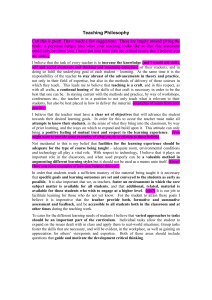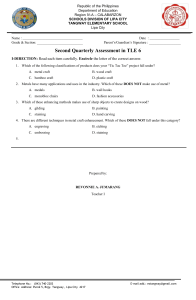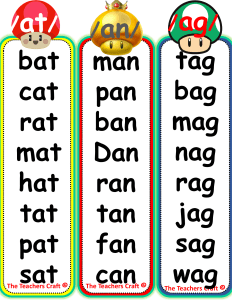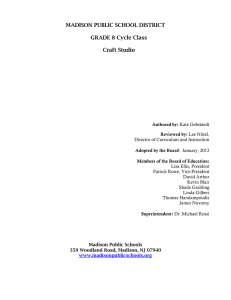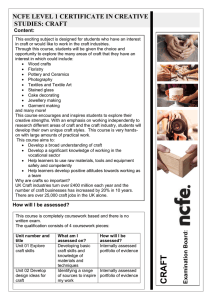Teaching English To Children Through Crafting ASHADI – FBS UNY
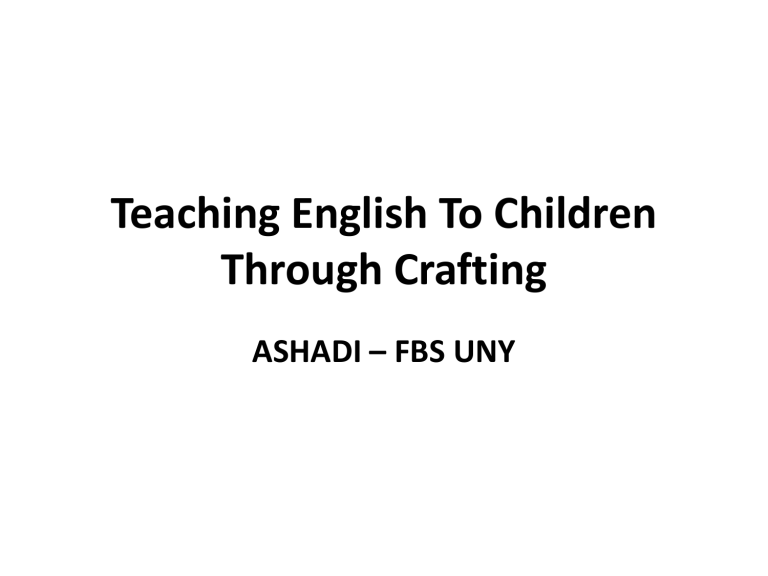
Teaching English To Children
Through Crafting
ASHADI – FBS UNY
Rationale
• Prinsip-prinsip pembelajaran Di TK (Bermain sambil belajar, orientasi pada perkembangan & kebutuhan anak,
Thematic , PAKEM, demokratis, bermakna, Terpadu dll)
• In any classroom, it is important to get students paying attention and listening. One effective way is to have students create simple, fun crafts. Children of all ages love to create things. It is an enjoyable experience and students have to listen carefully in order to learn how to do it properly. Be sure you speak slowly and clearly. Children listen in a different language require a few extra milliseconds for their brains to process the new information they are receiving in English.
Karakteristik perkembangan fisik motorik anak usia dini
Aims
• To integrate arts and crafts in the English classroom without losing sight of a learning objective
• To cater to a range of learner styles
• To successfully give instructions for a craft activity in order to include all children
• To reflect on having an organized approach to craft activities in order to be time efficient
Preparation
• It’s a good idea to have an example of the end product to show students before they get creating. This gives them a clear idea of what they are going to make. Making it yourself means you’ll also check how ‘doable’ it is for your students.
• A great way to show your students exactly what they are going to make and how to do it, is to watch a video of the process (if it’s available).
• Have all materials ready before you begin.
Perparation (2)
• Decide in advance how you are going to stage the activity. Will it be done over a series of classes? Where will you store the unfinished items? What parts will students need most help with and which bits can they do alone?
Tips
• Prepare everything before the lesson without removing the creative element of the activity.
Carefully consider the different stages of making the craft and decide which stages the children can do themselves, which they can't, which stages will allow them to be creative and which won't.
• Always ensure you have sufficient tools for all the children in the class. If a child has to wait a long time for glue or scissors learning there is less time for learning and they will get bored/lose attention.
Tips (cont’d)
• Consider what language the children will be using and more precisely what language you would like them to be using pre, during the craft activity and post-making. You don't necessarily have to insist on language work for all three stages, the object could be made to be used for a language exchange afterwards, but you mustn't lose sight of the fact you are in an English class and not an art class.
• Collect and store your craft supplies so that you don't waste time searching for bits of string at the last minute.
Tips (cont’d)
• Always have an activity whereby the children can actually use what they've made. Don't let the craft itself be the end of the learning cycle. Give the learners something meaningful to do with their object. This could be acting out a few phrases in English with a finger puppet or telling a story using a book they've made.
• Don't underestimate the value of letting a child create something that they can personalize. If they leave the classroom able to enthusiastically tell someone about their object, why they made it and what they did with it they are much more likely to leave with a positive image of learning English.

